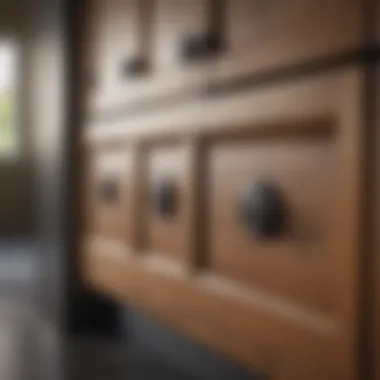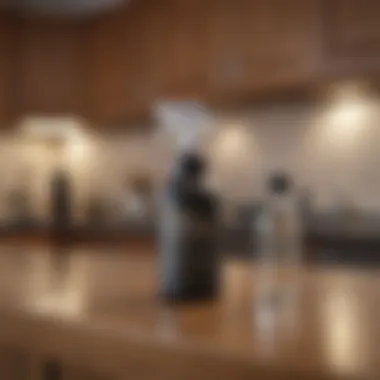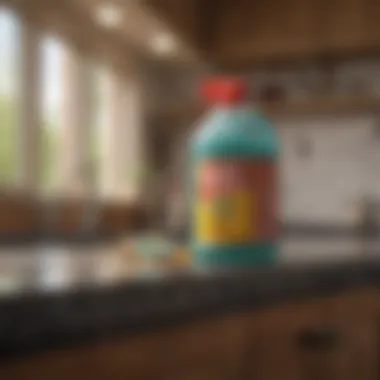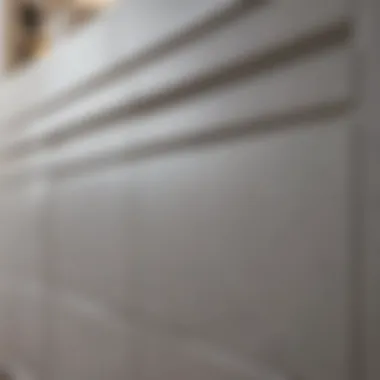Efficient Methods for Removing Grease from Cabinets


Intro
Grease buildup on kitchen cabinets is a prevalent issue faced by many homeowners. It undermines both the aesthetic appeal and hygiene of the kitchen space. The kitchen is often considered the heart of the home, and maintaining clean cabinets plays a role in creating an inviting environment. Understanding various methods for removing grease allows homeowners and design enthusiasts to preserve the beauty and functionality of their cabinetry.
Different cabinet materials require specific approaches for effective cleaning. Wood, laminate, and metal each have their strengths and weaknesses in relation to grease removal. Knowing the right technique and cleaning agent suited for your cabinet type is crucial. This article will explore commercial and homemade solutions, as well as maintenance tips and preventive measures that can help sustain your cabinet's integrity.
Homeowners seeking to preserve their kitchen’s aesthetic can benefit from these methods, ensuring their cabinets look attractive and remain in good condition for years. In the sections that follow, we will delve into the various strategies and best practices to combat grease stubbornly clinging to cabinets.
Understanding Kitchen Grease
Understanding the nature of kitchen grease is essential for effectively tackling grease removal from cabinets. Grease buildup can significantly detract from the aesthetic and hygiene of a kitchen. By recognizing what causes grease to accumulate, one can implement better cleaning techniques and preventive measures.
What Causes Grease Buildup?
Grease buildup in kitchens often results from cooking activities. Every time food is fried or sautéed, tiny grease particles can become airborne and settle on surfaces, including cabinets. Over time, this dirt forms a sticky layer that can attract further grime. Poor ventilation exacerbates the problem as it traps these particles inside the kitchen.
Additionally, cooking methods that involve high heat or oily ingredients tend to produce more grease. Foods such as bacon or fried foods release substantial grease, which can cling to surfaces. The type of cooking appliance also plays a role. For instance, open flame or gas stoves may produce more grease than electric ones.
A frequent lack of regular cleaning routines allows grease to build up. Regular maintenance is crucial. Without these practices, initial thin films of grease can transform into more challenging stains.
Types of Surfaces Affected
Understanding the types of surfaces in your kitchen is vital because different materials require different cleaning approaches to effectively remove grease.
Wood
Wood is a popular choice for cabinets due to its warm appearance and durability. However, it is very porous, which means it can absorb grease if not regularly maintained.
The unique feature of wood cabinets is their aesthetic appeal. They can enhance the overall kitchen design. However, the vulnerability of wood to stains makes it crucial to clean grease immediately.
Benefits of wood include its longevity and ability to be refinished. On the downside, it often requires more delicate cleaning methods to avoid damaging the finish.
Laminated Surfaces
Laminated surfaces are favored for their affordability and ease of maintenance. They have a smooth, non-porous finish that resists moisture and is less likely to absorb grease compared to wood.
The main characteristic of laminated cabinets is their wide range of colors and patterns. This feature makes them appealing for various design styles. While they are generally easier to clean, aggressive cleaners can damage the laminate. Thus, selecting suitable cleaning agents is crucial.
Painted Cabinets
Painted cabinets offer a protective layer over the wood beneath. The paint acts as a barrier against grease but can wear over time. The aesthetic versatility of colors makes them a common choice in many kitchens.
The primary benefit of painted cabinets is their ability to be customized, matching any kitchen theme. However, they may chip or scratch easier than other finishes, which can expose the wood to grease damage. This factor necessitates careful cleaning to preserve the paint.
Metal Finishes
Metal finishes, such as stainless steel, are popular in modern kitchens. They are sleek and contemporary but can show fingerprints and grease easily.
One of the key characteristics of metal finishes is their durability and resistance to heat. However, they are prone to scratching or dulling if not cleaned properly. It is vital to use non-abrasive materials to maintain their appearance.
In summary, grease removal depends heavily on the surface type. Each material presents unique challenges and benefits, highlighting the importance of tailored cleaning methods.
Commercial Cleaning Products
Commercial cleaning products are vital when it comes to effectively removing grease from kitchen cabinets. Their formulation is designed specifically to tackle the tough grease that can accumulate over time. These products not only provide efficient cleaning capabilities but also often come with ease of use, which is a significant advantage for homeowners seeking quick solutions to stubborn stains.


Degreasers
Degreasers are a critical subset of commercial cleaners. They are formulated to dissolve and remove greasy residues from various surfaces. The key characteristic of degreasers is their ability to penetrate thick layers of grease, breaking them down more effectively than standard cleaners.
Types of Degreasers
There are several types of degreasers available in the market, each with distinct formulations:
- Solvent-based degreasers - These are powerful and often used for industrial purposes. Though effective, they may emit strong fumes and require proper ventilation when used in kitchens.
- Water-based degreasers - These are safer for home use and are biodegradable. They are less harsh on surfaces and the environment, making them a popular choice among homeowners.
- Enzymatic degreasers - This type uses enzymes to break down grease and grime. They are known for being eco-friendly and are effective at removing organic stains.
Each type serves its own purpose depending on the severity of the grease stain and the surface being cleaned. The advantage of using degreasers is their targeted action against grease, making them popular choices for tackling stubborn kitchen cabinet residues.
How to Use Degreasers
Using degreasers correctly is essential for effective cleaning. The key aspect when using these products is to follow the manufacturer’s instructions closely. This ensures not just efficacy but also safety while cleaning.
- Preparation - Begin by removing any loose debris or dust from the cabinet surface.
- Application - Apply the degreaser directly on the greasy area. Allow it to sit for a few minutes to break down the residue.
- Scrubbing - Use a soft cloth or sponge to scrub the area gently, focusing on heavily soiled spots.
- Rinsing - Wipe down with clean water to eliminate any cleaner residue, preventing future build-up.
The unique feature of applying degreasers correctly lies in the time allowed for the product to activate. This waiting period can significantly enhance its effectiveness, making it easier to wipe away stubborn stains, thereby maintaining the cabinet's hygiene and appearance.
All-Purpose Cleaners
All-purpose cleaners provide versatility and convenience. These products are designed to tackle a range of cleaning tasks, including grease removal. While not as specialized as degreasers, their formulation often allows for effective grease cutting on surfaces not resistant to harsh chemicals. They save time and effort by providing a one-stop solution for multiple cleaning needs in the kitchen.
Specialized Kitchen Cleaners
Specialized kitchen cleaners are formulated with the specific needs of kitchen surfaces in mind. They often possess unique ingredients tailored to address the challenges of grease in culinary spaces. These cleaners can be effective in preserving the integrity of the materials used in your kitchen cabinets while still ensuring high cleanliness standards. The advantage of using such cleaners is their targeted approach, often delivering results that go beyond general cleaning. This makes them a valuable tool in the task of maintaining your kitchen's environment.
Homemade Cleaning Solutions
Homemade cleaning solutions play a crucial role in the quest for grease removal from kitchen cabinets. They often present safe, cost-effective alternatives to commercial products. Many homeowners appreciate using readily available items from their kitchens, which makes the process both accessible and sustainable. Furthermore, these solutions allow for customization based on personal preferences and sensitivities to certain ingredients.
Using homemade solutions can also reduce exposure to harsh chemicals, making them suitable for families with children or pets. The effectiveness of these options is a compelling reason to explore them further.
Vinegar and Baking Soda Mixture
Vinegar and baking soda together create a powerful duo for tackling stubborn grease. Vinegar's acidic nature works to break down grease, while baking soda provides a gentle abrasive action. To create this solution, mix equal parts of vinegar and baking soda. Allow it to fizz before applying it to the greasy areas on your cabinets. This reaction can help lift the grime effectively.
Use a soft cloth to wipe the mixture across the cabinet surface. For tougher spots, let the solution sit for a few minutes. Finally, rinse with water and dry the surface. This method is especially beneficial for wooden or laminated surfaces because it avoids harsh chemicals that could damage the finish.
Dish Soap and Warm Water
Dish soap combined with warm water offers another simple yet effective cleaning solution. This mixture is particularly advantageous due to its ease of preparation. To implement this method, add a few drops of mild dish soap to a bowl of warm water. Dip a cloth or sponge in the solution and wring it out to avoid excess water on the cabinets.
Wipe the greasy surfaces gently, ensuring complete coverage. Rinse with a clean, damp cloth to remove soap residue, which can leave streaks. This method is versatile and safe for all types of cabinet materials, making it a popular choice among homeowners.
Lemon Juice and Olive Oil
Lemon juice and olive oil provide a natural approach to cleaning greasy cabinets. Lemon juice contains citric acid, which helps break down grease, while olive oil can add shine to wooden finishes. To prepare this solution, mix one part lemon juice with two parts olive oil in a bowl. Apply the mixture using a soft cloth, focusing on the greasy areas.
After application, let the solution sit for a few minutes. This allows the lemon juice to work through any stubborn grime. Wipe off with a clean cloth to reveal shiny, clean surfaces. This method is particularly effective for wooden cabinets, bringing out their natural luster while removing grime.
Step-by-Step Cleaning Techniques
Cleaning kitchen cabinets effectively requires a structured approach. The Step-by-Step Cleaning Techniques are vital, ensuring that every part of the process is addressed thoroughly. By following these methods, homeowners can make sure that they not only remove the grease effectively but also maintain the integrity of the cabinet surfaces. Having a clear plan reduces the chance of damaging materials and promotes a thorough cleaning.
Preparation of the Area


Before diving into the cleaning process, adequate preparation is crucial. This step helps in creating a controlled environment, which minimizes distractions and hazards while cleaning. Begin by clearing the area around the cabinets. Remove any items such as dishes, utensils, or small appliances that might obstruct your movement or cleaning access.
Next, cover the countertop and floor with towels or old newspapers. This precaution can catch drips and spills, preventing further mess. Wearing gloves is also recommended. This protects your hands from harsh chemicals or grime. It can also keep your skin safe from the cleaning solutions you might use. An organized area not only enhances efficiency but also promotes safety.
Application of Cleaning Agent
The application of the cleaning agent is a paramount step in the cleaning process. This is when the grease starts to break down. Choose the right cleaning solution based on the cabinet material. For wooden cabinets, a gentle cleaner is advisable, while metal cabinets might require stronger solutions.
To begin, apply the cleaning agent liberally on a soft cloth or sponge. Avoid abrasive materials, as they might scratch or damage the surfaces. Work in sections, especially for large cabinets. This tactic ensures that no area is missed and allows for better control of the cleaning process. Apply the cleaner using circular motions to help lift the grease. Allow the product to sit for some time. This dwelling time can enhance the agent's effectiveness in breaking down the grease.
Rinsing and Drying Procedures
Once the cleaning agent has settled, rinsing and drying are the last essential steps. Rinsing ensures that any leftover cleaning agent and grease residue are thoroughly removed. Use a clean, damp cloth to wipe down the surfaces, removing any cleaning solution that remains.
After rinsing, it is crucial to dry the cabinets to prevent moisture damage. Use a dry towel to wipe down the surfaces, ensuring an effective seal against moisture. Additionally, make sure to check the edges and corners where water can pool and linger.
Keeping your kitchen cabinets clean is not just about aesthetics; it also helps preserve their structure and finish over time.
Addressing Stubborn Grease Stains
Stubborn grease stains on kitchen cabinets are a common issue that can greatly affect both the appearance and hygiene of your kitchen. Understanding the nature of these stains is essential. Grease can accumulate from everyday cooking activities, particularly if you regularly fry or sauté foods. Over time, without proper cleaning, this grease can harden and become much more challenging to remove.
One of the significant benefits of learning how to effectively tackle these stubborn stains is the preservation of your kitchen cabinets. When addressed promptly, you can maintain the cabinetry's finish and prolong its lifespan.
Specific considerations come into play when dealing with stubborn grease. Different surfaces may require tailored approaches to prevent damage while ensuring a thorough cleaning. For example, wooden cabinets may be sensitive to certain cleaning agents, whereas metal finishes can handle a different level of abrasive cleaning.
When to Use Abrasives
Abrasives can be effective for removing grease stains, but knowing when to use them is crucial. If you find that standard cleaning solutions are insufficient, it may be time to consider abrasives. However, caution is necessary. Abrasives can scratch or dull the finish of sensitive surfaces such as wood or painted cabinets.
Before using abrasives, first try gentler methods and cleaning solutions. If these do not yield results, opt for a fine-grade abrasive cleaner. Always do a patch test in an inconspicuous area to confirm that the abrasive will not damage the surface.
Soaking Techniques
Soaking techniques can be surprisingly effective in loosening stubborn grease. This method involves applying a cleaning solution directly to the stains and allowing it to sit for a period. For instance, applying a mix of vinegar and baking soda can break down grease.
Start by saturating a cloth with the solution and gently laying it over the stain. Leave it for about 15 minutes, which allows the solution to penetrate the grease. After soaking, use a soft cloth to wipe away the residue. This two-step process is often successful in achieving better results than immediate scrubbing.
Reapplication of Cleaning Agents
Sometimes, the first application of a cleaning agent may not completely remove stubborn grease stains. In these cases, reapplication is necessary. After initial cleaning, evaluate the condition of the surface. If the stain persists, reapply your chosen cleaning solution. Allow it to sit for an extended period before attempting to remove it again.
Varying your cleaning agents can also be beneficial. For instance, if vinegar does not work well, try using a dish soap and warm water mixture. Rotate cleaning agents to find the most effective ones for your specific cabinet finishes.
Effective care and maintenance techniques can keep your kitchen cabinets looking pristine for years to come.
Material-Specific Considerations
Understanding the specific material of your kitchen cabinets is crucial when it comes to cleaning grease effectively. Different surfaces respond variably to cleaning agents. This can impact both the effectiveness of the cleaning process and the long-term durability of the materials involved. Utilizing proper methods tailored for each material type helps to avoid damage, ensuring cabinets remain appealing and intact.
For homeowners, this information not only preserves the aesthetic of your kitchen but also prolongs the life of your cabinetry. Each material—wood, laminated surfaces, and metal—requires unique care techniques. Knowledge of these nuances can lead to more efficient cleaning and better preservation over time.
Cleaning Wooden Cabinets
Wooden cabinets can add warmth and beauty to any kitchen. However, they are also absorbent and sensitive to harsh chemicals. To clean wooden cabinets, it is advisable to avoid excessive moisture which can warp the wood.
Key steps for cleaning wooden cabinets include:


- Use mild soap solutions: Mix a small amount of dish soap into water. Use a soft cloth dampened with this solution to wipe down surfaces, ensuring to follow the grain of the wood.
- Avoid abrasive cleaners: These can scratch the wooden surface or damage the finish.
- Dry thoroughly: After cleaning, wipe down with a dry cloth to remove any residue of moisture.
Laminated Cabinet Care
Laminated cabinets are more resistant to moisture but can still succumb to grease buildup. Their surface is usually smooth, making it easier to clean, but special attention should still be given to avoid damaging the laminate surface.
When caring for laminated cabinets, consider the following:
- Use a gentle cleaner: All-purpose cleaners work well. Always read the label to ensure compatibility.
- Soft cloths are key: Avoid rough scrubbers. Soft microfiber cloths can effectively lift grease without damaging the surface.
- Be cautious around edges: The laminate can peel if too much force is applied, especially near the edges.
Maintaining Metal Finishes
Metal cabinets stand out for their modern aesthetic but require careful maintenance. They can be prone to scratching and tarnishing, and using the wrong cleaning agents can lead to corrosion.
To maintain metal finishes, follow these guidelines:
- Use specialized metal cleaners: Products designed specifically for metal help remove grease without causing damage.
- Avoid acidic substances: They can corrode and leave unsightly marks. Instead, opt for neutral pH solutions.
- Regular wiping: Regularly wipe down surfaces to prevent buildup, using a soft cloth and gentle cleaner.
Always test cleaning agents on a small, inconspicuous area before full application, ensuring they do not cause discoloration or damage.
By tailoring your cleaning methods to fit each unique material, you can ensure longer-lasting and more beautiful kitchen cabinets.
Preventive Measures
Preventive measures play a vital role in maintaining the cleanliness and integrity of kitchen cabinets. By adopting a proactive approach, homeowners can significantly reduce the accumulation of grease, which not only affects the aesthetic appeal of the kitchen but also contributes to hygiene concerns. Establishing a routine can help keep cabinets looking their best over time.
Taking preventive measures involves understanding the sources of grease and addressing them before they become a problem. This can include adjusting cooking habits and implementing maintenance strategies that align with the type of cabinetry one has. Moreover, using cleaning agents and protective products can offer long-term benefits, minimizing the need for intensive scrubbing and deep cleaning later on.
Regular Cleaning Schedule
Creating a regular cleaning schedule is one of the most effective preventive measures. Dedicating time each week to wipe down cabinets can prevent grease buildup. The frequency may vary depending on cooking habits and kitchen usage.
- Frequency: A weekly cleaning routine is generally sufficient for most households. For heavy cookers, consider increasing this to twice a week.
- Cleaning Agents: Use mild cleaners like soapy water or vinegar solutions. Avoid aggressive chemicals that may damage finishes.
- Methods: Wipe cabinets with microfiber cloths to avoid scratching surfaces. Make sure to dry the cabinets after cleaning to prevent moisture damage.
Use of Protective Coatings
Applying protective coatings can serve as a barrier against grease and dirt. These coatings can help maintain the surface quality and appearance of kitchen cabinets. Different finishes require different types of protective treatments.
- Types of Coatings: Options include clear polyurethane for wooden cabinets and specialized sprays for laminate or metal finishes.
- Application: Follow manufacturer instructions for application to ensure proper adhesion and effectiveness.
- Reapplication: Regularly check the condition of the coating and reapply as necessary, especially in high-use areas.
Using protective coverings not only aids in cleaning but also prolongs the lifespan of cabinets.
Preventive measures such as regular cleaning and protective coatings offer both aesthetic and practical benefits for kitchen cabinetry.
Overall, implementing preventive measures is essential for anyone looking to maintain their kitchen cabinets. These efforts can reduce the amount of time spent on deep cleaning and help preserve the cabinetry's finish, ensuring it remains an attractive feature of the home.
Epilogue
In summary, the process of removing grease from kitchen cabinets is not just a matter of aesthetics; it has significant implications for hygiene and the longevity of your cabinetry. The techniques outlined in this article, whether utilizing commercial products or homemade solutions, cater to diverse preferences and material types. Homeowners and design enthusiasts can benefit greatly from an understanding of these approaches.
Recap of Effective Techniques
To effectively address grease accumulation, the following methods have been discussed:
- Commercial Cleaning Products: These include degreasers, all-purpose cleaners, and specialized kitchen cleaners, each serving unique purposes in grease removal.
- Homemade Solutions: The simplicity of items like vinegar, baking soda, dish soap mixed with warm water, and lemon juice combined with olive oil can be quite effective and economical.
- Step-by-Step Cleaning: Preparation of the area, proper application of the cleaning agents, and meticulous rinsing and drying are crucial to achieving a clean finish.
- Material-Specific Considerations: Understanding how different surfaces react to cleaning methods ensures an appropriate approach without causing damage.
- Preventive Measures: Establishing a schedule for regular cleaning and applying protective coatings can significantly reduce the frequency of deep cleaning tasks.
By integrating these strategies into your routine, maintaining grease-free cabinets becomes more achievable.
Final Thoughts on Maintenance
Ongoing maintenance plays a critical role in the long-term preservation of kitchen cabinetry. A consistent cleaning schedule, combined with preventive measures, not only retains the beauty of the cabinets but also protects their surface integrity. By using the right products, homeowners can reduce oily buildup and promote a healthier kitchen environment.
Regular attention to kitchen surfaces will save time and effort during deep cleaning sessions. Moreover, understanding the nature of the materials involved will enhance the effectiveness of your maintenance routines. Ultimately, adopting smart cleaning practices ensures that kitchen cabinets remain a lasting highlight of your home.















